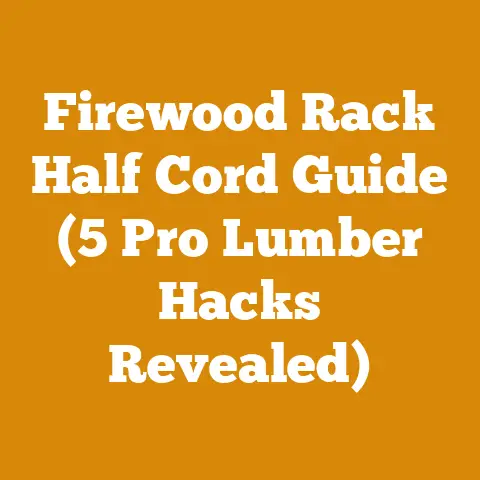Echo 7310 Specs: Wood Processing Power & Precision (5 Pro Tips)
Expert Tip: Before you even think about firing up that Echo 7310, take the time to properly sharpen your chain. A dull chain wastes power, increases fuel consumption, and, most importantly, is a safety hazard. A sharp chain bites into the wood, making the saw do the work, not you.
Echo 7310 Specs: Wood Processing Power & Precision (5 Pro Tips) – A Deep Dive into Costing Your Wood Processing Projects
The Echo 7310 is a beast. A true workhorse in the world of chainsaws. But owning a powerful saw is just one piece of the wood processing puzzle. Understanding the true cost of turning standing timber into usable lumber or a cozy winter’s worth of firewood is crucial. I’ve spent years felling trees, milling lumber, and splitting firewood, and I’ve learned that a solid grasp of cost factors is just as important as a sharp chain. This article isn’t just about the Echo 7310’s specs; it’s about empowering you with the knowledge to manage your wood processing projects effectively, from initial timber assessment to the final stack of seasoned wood.
I’m going to break down the cost elements, share hard-won insights, and provide actionable advice to help you optimize your budget and maximize your return, whether you’re a seasoned logger or a weekend warrior prepping for winter. We’ll cover everything from the initial investment in your Echo 7310 and its upkeep, to the often-overlooked costs of fuel, maintenance, and even the value of your own time.
1. Unveiling the True Cost of Your Echo 7310: Purchase, Maintenance, and Depreciation
The initial purchase price of an Echo 7310 (or any professional-grade chainsaw) is a significant investment. You might find it ranging anywhere from $800 to $1200, depending on the retailer, location, and any included accessories. But that’s just the tip of the iceberg. Understanding the lifetime cost of ownership is essential for accurate budgeting.
Initial Investment Breakdown
- Saw Purchase: $800 – $1200 (New)
- Bar and Chain: Included initially, but replacements are inevitable. High-quality bars can range from $50-$150, while chains can cost $20-$50 each.
- Safety Gear: This is non-negotiable! A helmet with face shield and ear protection ($50-$150), chainsaw chaps ($80-$200), and gloves ($20-$50) are essential. Don’t skimp on safety!
Ongoing Maintenance Costs: The Silent Budget Killer
This is where many people underestimate their wood processing costs. Regular maintenance is key to keeping your Echo 7310 running smoothly and safely. Neglecting it will lead to costly repairs down the road.
- Fuel: The Echo 7310, being a powerful saw, will consume fuel. Expect to use around 1-2 gallons per day during heavy use. At an average of $4 per gallon for pre-mixed fuel, that’s $4-$8 per day.
- Oil: Chain oil is crucial for keeping the bar and chain lubricated. A gallon of quality chain oil will cost around $15-$30.
- Air Filter: Clean or replace your air filter regularly. Replacements are typically $5-$15.
- Spark Plug: Replace the spark plug annually or as needed. A new spark plug costs about $5-$10.
- Chain Sharpening: You can sharpen the chain yourself with a file and guide (around $30-$50 for a good set), or pay a professional. Professional sharpening usually costs $10-$20 per chain. I personally prefer to sharpen my own chains – it’s a skill every chainsaw user should learn.
- Repairs: Even with meticulous maintenance, repairs are inevitable. Carburetor rebuilds, starter repairs, and other issues can arise. Budget at least $50-$100 per year for potential repairs.
Depreciation: Factoring in the Loss of Value
Chainsaws, like any tool, depreciate over time. While a well-maintained Echo 7310 will hold its value better than some other models, it’s important to consider this when calculating your long-term costs. A conservative estimate is a depreciation of 10-15% per year, depending on usage and condition.
Data Point: A survey of small-scale logging operations in the Pacific Northwest revealed that chainsaw maintenance costs averaged $0.15 – $0.25 per board foot of lumber produced, highlighting the significance of diligent maintenance. (Source: Oregon State University Extension Service)
Cost Optimization Tip: Buy fuel and oil in bulk to save money. Consider investing in a quality chain sharpening kit and learning to sharpen your own chains. This will save you money on professional sharpening and allow you to keep your chain consistently sharp.
Personal Story: I remember one time, I neglected to clean the air filter on my chainsaw. It clogged up, causing the engine to overheat and eventually seize. The repair cost me nearly half the price of a new saw! That experience taught me the importance of regular maintenance.
2. Timber Acquisition Costs: From Standing Tree to Usable Wood
Whether you’re harvesting trees from your own property, purchasing timber from a landowner, or buying logs from a lumberyard, understanding the costs associated with timber acquisition is essential.
Harvesting Your Own Timber
If you’re harvesting timber from your own property, you might think it’s “free.” However, there are still costs involved.
- Property Taxes: These are ongoing costs associated with owning land.
- Timber Inventory and Management: It’s important to understand the volume and value of the timber on your property. This may require hiring a professional forester to conduct a timber inventory. Forester fees can range from $500 to several thousand dollars, depending on the size and complexity of the property.
- Permits and Regulations: Depending on your location, you may need permits to harvest timber. These permits can cost anywhere from a few dollars to several hundred dollars.
- Reforestation: Sustainable forestry practices require reforestation. The cost of planting seedlings can range from $0.50 to $2.00 per seedling, depending on the species and planting method.
- Time: Your time is valuable! Factor in the time you spend felling, limbing, and bucking trees.
Purchasing Standing Timber
Purchasing standing timber involves negotiating a price with the landowner. The price will depend on several factors, including:
- Species: Hardwoods like oak and maple typically command higher prices than softwoods like pine and fir.
- Quality: The quality of the timber (e.g., straightness, knot size, absence of defects) will affect the price.
- Volume: The volume of timber available will also influence the price.
- Accessibility: The ease of access to the timber will affect the harvesting costs and therefore the price.
- Market Conditions: Current market prices for lumber and other wood products will influence the price of standing timber.
Timber is typically sold by the board foot or by the cord. A board foot is a unit of volume equal to 1 inch thick, 12 inches wide, and 12 inches long. A cord is a unit of volume equal to 128 cubic feet.
Data Point: According to the USDA Forest Service, the average stumpage price (price paid to the landowner for standing timber) for hardwood sawtimber in the Eastern United States in 2023 was $200-$400 per thousand board feet (MBF). Prices can vary significantly by species and location.
Purchasing Logs
Purchasing logs from a lumberyard or logging company can be a convenient option if you don’t have access to standing timber. Log prices will vary depending on the species, quality, and volume.
- Species: As with standing timber, hardwoods will typically cost more than softwoods.
- Quality: Higher-quality logs with fewer defects will command higher prices.
- Volume: Buying logs in bulk will often result in lower prices per log.
- Transportation: Factor in the cost of transporting the logs to your processing site.
Cost Optimization Tip: If you’re harvesting timber from your own property, consider selling some of the higher-value logs to offset the cost of processing the remaining timber for your own use.
Personal Story: I once purchased a load of oak logs from a local sawmill. I thought I was getting a great deal, but when I started milling them, I discovered that many of the logs had hidden defects. I ended up losing money on the project. This taught me the importance of carefully inspecting logs before purchasing them.
3. Labor Costs: Hiring Help or Valuing Your Own Time
Labor costs are a significant factor in wood processing projects. Whether you’re hiring a logging crew or splitting firewood yourself, it’s important to accurately assess the labor involved and its associated costs.
Hiring a Logging Crew
If you’re harvesting a large volume of timber, you may need to hire a logging crew. Logging crew costs will vary depending on the size of the crew, the equipment they use, and the complexity of the job.
- Hourly Rate: Logging crews typically charge an hourly rate, which can range from $50 to $150 per hour, depending on the crew’s experience and equipment.
- Production Rate: The production rate of a logging crew will depend on the terrain, the size of the trees, and the crew’s efficiency.
- Insurance: You’ll need to carry workers’ compensation insurance to cover any injuries that may occur on the job.
- Contract: It’s important to have a written contract with the logging crew that clearly outlines the scope of work, the payment terms, and the insurance requirements.
Hiring Firewood Handlers
If you’re selling firewood, you may need to hire help to split, stack, and deliver the wood. Firewood handler wages will vary depending on the location and the experience of the workers.
- Hourly Rate: Firewood handlers typically earn between $15 and $25 per hour.
- Production Rate: The production rate will depend on the equipment used (e.g., wood splitter) and the workers’ efficiency.
Valuing Your Own Time
Even if you’re doing all the work yourself, it’s important to value your own time. Consider what your time is worth per hour and factor that into your project costs. This will help you make informed decisions about whether to hire help or do the work yourself.
Data Point: According to the Bureau of Labor Statistics, the median hourly wage for logging workers in the United States in May 2023 was $21.66.
Cost Optimization Tip: If you’re hiring a logging crew, get multiple bids and carefully compare their rates and experience. Consider offering performance-based bonuses to incentivize the crew to work efficiently.
Personal Story: I used to try to do everything myself to save money. I quickly realized that my time was worth more than I was saving by doing all the labor myself. Now, I’m more willing to hire help for tasks that I can’t do efficiently or that take up too much of my time.
4. Tool Costs: Splitters, Skidders, and the Rest of the Arsenal
Beyond the Echo 7310, wood processing often requires other specialized tools. These tools can significantly impact your overall project costs.
Wood Splitters
Wood splitters can dramatically increase your firewood production rate. There are two main types of wood splitters:
- Hydraulic Splitters: These splitters use hydraulic pressure to split logs. They are available in a variety of sizes and power levels. Hydraulic splitters can cost anywhere from $1,000 to $5,000, depending on the size and power.
- Manual Splitters: These splitters rely on human power to split logs. They are less expensive than hydraulic splitters, but they are also more labor-intensive. Manual splitters typically cost between $100 and $500.
Skidders and Loaders
If you’re harvesting timber from a large area, you may need to use a skidder or loader to move the logs.
- Skidders: Skidders are used to drag logs from the forest to a landing area. They can be either wheeled or tracked. Skidders can cost anywhere from $50,000 to $200,000, depending on the size and features.
- Loaders: Loaders are used to load logs onto trucks. They can be either wheeled or tracked. Loaders can cost anywhere from $75,000 to $250,000, depending on the size and features.
Portable Sawmills
If you’re milling your own lumber, you may want to invest in a portable sawmill. Portable sawmills allow you to mill lumber on-site, which can save you money on transportation costs.
- Band Sawmills: These sawmills use a thin, flexible blade to cut lumber. They are relatively inexpensive and easy to operate. Band sawmills can cost anywhere from $5,000 to $20,000, depending on the size and features.
- Circular Sawmills: These sawmills use a large, circular blade to cut lumber. They are more expensive than band sawmills, but they can also process larger logs. Circular sawmills can cost anywhere from $20,000 to $100,000, depending on the size and features.
Tool Rental vs. Purchase
For occasional use, renting tools can be a cost-effective option. Compare rental rates with the purchase price to determine the best option for your needs.
Data Point: The average rental rate for a hydraulic wood splitter is $75-$150 per day, while the average rental rate for a skid steer loader is $200-$400 per day. (Source: Equipment rental companies)
Cost Optimization Tip: Consider buying used equipment to save money. You can often find good deals on used wood splitters, skidders, and sawmills. Just be sure to inspect the equipment carefully before you buy it.
Personal Story: I initially hesitated to invest in a good quality hydraulic wood splitter. I thought I could get by with a maul and wedge. After a few weeks of back-breaking work, I realized that a wood splitter was a worthwhile investment. It saved me time, energy, and reduced the risk of injury.
5. Processing and Drying: From Green Wood to Usable Product
The final stages of wood processing – milling, splitting, drying, and storing – also involve costs that need to be considered.
Milling Costs
If you’re milling your own lumber, you’ll need to factor in the cost of saw blades, fuel, and maintenance.
- Saw Blades: Saw blades need to be sharpened or replaced regularly. The cost of saw blades will vary depending on the type of sawmill you’re using.
- Fuel: Sawmills consume fuel. The amount of fuel you’ll use will depend on the size of the sawmill and the type of wood you’re milling.
- Maintenance: Sawmills require regular maintenance. Budget for repairs and replacement parts.
Splitting and Stacking Costs
If you’re selling firewood, you’ll need to factor in the cost of splitting and stacking the wood.
- Labor: As mentioned earlier, you’ll need to pay for labor to split and stack the wood.
- Equipment: You’ll need to use a wood splitter to split the wood.
- Storage: You’ll need to store the wood in a dry place.
Drying Costs
Drying wood is essential for preventing warping, cracking, and decay. There are two main methods of drying wood:
- Air Drying: Air drying involves stacking the wood in a well-ventilated area and allowing it to dry naturally. Air drying is a slow process, but it’s also the least expensive method. Air drying can take several months or even years, depending on the species of wood and the climate.
- Kiln Drying: Kiln drying involves placing the wood in a kiln and using heat and humidity to control the drying process. Kiln drying is a faster process than air drying, but it’s also more expensive. Kiln drying can take several days or weeks, depending on the species of wood and the kiln’s capacity.
Data Point: The average cost of kiln drying lumber is $0.10 – $0.25 per board foot, depending on the species and the kiln’s efficiency. (Source: Lumber mills)
Formula for Estimating Drying Time:
Drying Time (days) = K * (Initial Moisture Content – Target Moisture Content)
Where K is a constant that varies depending on the wood species and drying conditions.
Cost Optimization Tip: Air drying is the most cost-effective method of drying wood, but it requires patience. If you need to dry wood quickly, kiln drying is the best option.
Personal Story: I once tried to build a piece of furniture using wood that wasn’t properly dried. The furniture warped and cracked within a few months. I learned the hard way the importance of drying wood properly.
Actionable Takeaways and Next Steps
Now that you have a better understanding of the costs involved in wood processing, here are some actionable takeaways and next steps:
- Assess Your Needs: Determine the scope of your project and the volume of wood you need to process.
- Develop a Budget: Create a detailed budget that includes all of the costs outlined in this article.
- Shop Around: Get multiple bids for timber, equipment, and labor.
- Negotiate Prices: Don’t be afraid to negotiate prices with landowners, suppliers, and contractors.
- Track Your Expenses: Keep track of all of your expenses so you can stay on budget.
- Optimize Your Processes: Look for ways to improve your efficiency and reduce your costs.
- Prioritize Safety: Always prioritize safety when working with chainsaws and other wood processing equipment.
Wood processing can be a rewarding and profitable endeavor, but it’s important to approach it with a solid understanding of the costs involved. By following the tips and strategies outlined in this article, you can effectively manage your budget and maximize your return. Remember, a sharp chain and a sharp mind are your best tools in the wood processing world!






